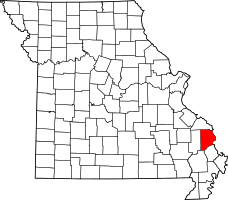Trail of Tears State Park
| Trail of Tears State Park | |
| Missouri State Park | |
| Country | United States |
|---|---|
| State | Missouri |
| County | Cape Girardeau |
| Elevation | 486 ft (148 m) [1] |
| Coordinates | 37°28′20″N 89°29′37″W / 37.47222°N 89.49361°WCoordinates: 37°28′20″N 89°29′37″W / 37.47222°N 89.49361°W [1] |
| Area | 3,415.39 acres (1,382 ha) [2] |
| Established | 1957 |
| Management | Missouri Department of Natural Resources |
|
Location in Missouri | |
| Website: Trail of Tears State Park | |
|
Trail of Tears State Park Archeological Site | |
 | |
| Nearest city | Oriole, Missouri |
| Area | 19.3 acres (7.8 ha) |
| NRHP Reference # | 70000326[3] |
| Added to NRHP | December 2, 1970 |
Trail of Tears State Park is a state-owned, public recreation area covering 3,415 acres (1,382 ha) along the Mississippi River in Cape Girardeau County, Missouri. The state park stands as a memorial to those Cherokee Native Americans who died on the Cherokee Trail of Tears.[4] The park's interpretive center features exhibits about the Trail of Tears as well as displays and specimens of local wildlife. An archeological site in the park was added to the National Register of Historic Places in 1970.[5]
Activities and amenities
Activities in the park include camping, picnicking, swimming, and hiking with trails for both backpackers and equestrians. Fishing is provided at 20-acre (8.1 ha) Lake Boutin and on the Mississippi River. A lookout offers a view of the river and Illinois on the opposite shore. There are four trails at Trail of Tears:
- Peewah Trail – 9 miles (14 km)
- Sheppard Point Trail – 3 miles (4.8 km)
- Lake Trail – 2.25 miles (3.62 km)
- Nature Trail – 0.6 miles (0.97 km)
See also
References
- 1 2 "Trail of Tears State Park". Geographic Names Information System. United States Geological Survey.
- ↑ "Missouri State Park Advisory Board Annual Report 2008". Missouri Department of Natural Resources. Retrieved October 13, 2015.
- ↑ National Park Service (2010-07-09). "National Register Information System". National Register of Historic Places. National Park Service.
- ↑ "Trail of Tears State Park". Missouri State Parks. Missouri Department of Natural Resources. Retrieved September 4, 2014.
- ↑ "Trail of Tears State Park Archeological Site". National Register of Historic Places. National Park Service. Retrieved October 13, 2015.
External links
- Trail of Tears State Park Missouri Department of Natural Resources


